Continuous PNAD: unemployment rate is 11.1%, underutilization rate is 24.3% in quarter ending in December
February 24, 2022 09h00 AM | Last Updated: February 25, 2022 03h34 PM
The unemployment rate (11.1%) in the moving quarter between October and December 2021 fell 1.5 percentage points against the quarter from July to September 2021 (12.6%) and retreated 3 p.p. against the same quarter in 2020 (14.2%). The annual average rate in 2021 (13.2%) was 0.6 p.p. lower than in 2020 (13.8%).
| Indicator/Period | Oct-Nov-Dec 2021 | Jul-Aug-Sep 2021 | Oct-Nov-Dec 2020 |
|---|---|---|---|
| Unemployment rate | 11.1% | 12.6% | 14.2% |
| Underutilization rate | 24.3% | 26.5% | 28.8% |
| Usual real earnings | R$2,447.00 | R$2,538.00 | R$2,742.00 |
| Change of usual real earnings in relation to: | -3.6% | -10.7% | |
The unemployed population (12 million persons) in the quarter between October and December 2021 decreased 10.7% (less 1.4 million persons) against the quarter ended in September and fell 16.7% (less 2.4 million persons) against the same moving quarter of 2020. The annual average added up to 13.9 million persons in 2021, against 13.8 million persons in 2020.
The employed population (95.7 million persons) increased 3.0% (2.8 million persons) against the previous quarter and increased 9.8% (8.5 million persons) against the same quarter of 2020. The annual average grew 5% between 2020 and 2021, hitting 91.3 million persons in 2021.
The employment-population ratio (percentage of employed persons in the working age population) reached 55.6%, increasing 1.5 p.p. against the previous quarter (54.1%) and 4.5 p.p. in the annual comparison (51.1%). In 2021, the annual average was 53.2%, 2 p.p. higher than that of 2020 (51.2%), which was the lowest one in the time series.
The composite underutilization rate (24.3%) fell 2.2 p.p. in relation to the quarter from July to September 2021 (26.5%) and 4.5 p.p. compared with the same quarter of 2020 (28.8%). In 2021, the annual average rate hit the second highest figure in the time series (27.2%), only below that of 2020 (28.2%).
The underutilized population (28.3 million persons) fell 7.8% (less 2.4 million persons) against the previous quarter (30.7 million persons) and 12.9% (less 4.2 million persons) in comparison with the same quarter of 2020 (32.5 million underutilized workers). The annual average of 2021 was 31.3 million persons, a reduction of 1.2% over 2020.
The time-related underemployed population (7.4 million) fell 5,2% against the previous quarter (a decrease of 402 thousand persons) and increased 7.3% in the year (6.9 million persons). The annual average was 7.5 million persons, an increase of 18.1% over 2020.
The population out of the workforce (64.5 million persons) fell 1.4% (less 931 thousand persons) against the previous quarter and fell 6.5 % in the year (less 4.5 million persons).
The discouraged population (4.8 million persons) fell 6.9% (less 356 thousand persons) against the previous quarter and decreased 16.6% (less 950 thousand persons) against the same period of 2020. The annual average dropped from 5.5 million in 2020 (record in the time series) to 5.3 million persons in 2021.
The percentage of discouraged persons in the workforce a (4.4%) declined from the previous quarter (0.4 p.p.) and also from the same quarter in 2020 (1.0 p.p.).
The number of persons employed with a formal contract in the private sector (excluding domestic workers) reached 34.5 million persons, an increase of 2.9% (more 987 thousand persons) against the previous quarter and of 9.2% (more 2.9 million persons) over 2020. The annual average increased 2.6% in 2021, adding up to 32.9 million persons against 32.1 in 2020.
The number of workers without a formal contract in the private sector (12.4 million persons) rose 6.4% (753 thousand persons) against the previous quarter and 18.3% (1.9 million persons) against 2020. The annual average increased 11.1%, changing from 10.1 million in 2020 to 11.2 million persons in 2021.
The number of self-employed workers (25.9 million persons) increased 1.9% (483 thousand persons) in the monthly comparison and 13.1% (3 million persons) in the annual comparison. The annual average hit 24.9 million persons, a rise of 11.1% (or more 2.5 million persons) against 2020.
The number of domestic workers (5.7 million persons) increased 6.4% (more 341 thousand persons) in the quarter and 22.1% (more 1.0 million persons) in the year. In 2021, the annual average increased 6.6% over 2020, hitting 5.2 million persons.
The informality rate was 40.7% of the employed population or 38.9 million informal workers. In the quarter between July and September, the rate had been 40.6% and, in the same quarter of 2020, 39%. The annual average changed from 38.3% in 2020 to 40.1% in 2021.
Usual real earnings (R$2,447) decreased 3.6% against the previous quarter and decreased 10.7% in relation to the same quarter in 2020. It was the lowest earnings in the time series, started in 2012. The annual average was R$2,587, a drop of 7% against 2020 (or less R$195).
The usual real wage bill (R$229.4 billion) did not record any statistically significant change in both comparisons. The annual average was R$230.6 billion in 2021, a reduction of 2.4% (less R$5.6 billion) compared with 2020.

In the moving quarter between October and December 2021, the workforce (employed and unemployed persons) amounted to 107.8 million persons, having increased 1.2% (1.3 million persons) against the quarter from July to September 2021 and 6%1(6.2 million persons) against the same quarter in 2020.
In 2021, the annual average was 105.2 million persons, an increase of 4.3% (or more 4.4 million persons) in relation to 2020.

None of the groups of activities recorded an increase in the usual average real earnings against the previous quarter, but two of them recorded decreases: Industry (6.9% or less R$176) and Public administration, defense and social security (4.6% or less R$174). None of the other groups recorded significant changes.
In the annual comparison, no group recorded increase in earnings, but five of them faced a decrease: Agriculture, livestock, forestry, fishing and aquaculture (5.8% or less R$94), Industry (15.9% or less R$450), Trade, repair of motor vehicles and motorcycles (7.2% or less R$155), Information, communication and financial, real estate, professional and administrative activities (9.3% or less R$357) and Public administration (12.5% or less R$508).
In the quarterly comparison, none of the employment types recorded increases in earnings, though four of them dropped: Workers with a formal contract (3.3% or less R$79), Workers without a formal contract (5.5% or less R$91), Workers in the public sector (including military and civil servants) (2.5%, or less R$100) and Employers (6.2% or less R$386). None employment types increased their earnings against the same moving quarter in 2020.
Employed population by activity group - quarter ended in December
Employment increased in seven out of ten groups of activities against the previous moving quarter: Construction (3.3% or more 242 thousand persons), Trade, repair of motor vehicles and motorcycles (3.4% or more 602 thousand persons), Lodging and food (5.2% or more 253 thousand persons), Information, communication, and financial, real estate, professional and administrative activities (3.3% or more 367 thousand persons), Public administration (2.2% or more 357 thousand persons), Other services (11.8% or more 521 thousand persons) and Domestic services (6.4% or more 346 thousand persons). The other groups did not record significant changes.
Against the same moving quarter in 2020, employment increased in nine groups: Agriculture, livestock, forestry, fishing and aquaculture (4.5% or more 381 thousand persons), General industry (9.1% or more 1.0 million persons), Construction (17.4% or more 1.1 million persons), Trade, repair of motor vehicles and motorcycles (11.6% or more 1.9 million persons), Transportation, storage and mailing (10.0% or more 441 thousand persons), Lodging and food (23.9% or more 994 thousand persons), Information, communication and financial, real estate, professional and administrative activities (7.2% or more 768 thousand persons), Other services (14.7% or more 631 thousand persons) and Domestic services (21.7%, or more 1.0 million persons).
Employed population by activity group - annual average of 2021
Construction stood out in the annual average, the activity with the highest percentage of increase in the employed population (13.8%), adding up to 7 million workers. Agriculture, livestock, forestry, fishing and aquaculture was the second activity with the highest percentage of increase in the employed population (7.2%) between 2020 and 2021, changing from 8.2 to 8.8 million workers. Information, communication and financial, real estate, professional and administrative activities also reported an important growth in 2021: 6.8%. The contingent in this activity stayed at 11.1 million workers.
Trade and repair of motor vehicles and motorcycles grew 5.4% (more 881 thousand persons) over 2020, with a population of 17.3 million persons. General industry registered 11.9 million workers in 2021, an increase of 3.9% (more 446 thousand persons) over 2020.
Among the groups of services, Domestic services stood out with the highest increase (6.7% or more 327 thousand persons) in 2021, followed by the group of Lodging and food (5.4% or more 238 thousand persons). The former activity counted with 5.2 million workers and the latter, with 4.6 million.
The group of Transportation, storage and mailing counted with 4.7 million workers in 2021 and grew 4.1% (more 184 thousand persons) in relation to 2020. Other services, with 4.4 million workers, grew 1.4% over 2020. Lastly, Public administration counted with 16.2 million workers in 2021, remaining stable in relation to 2020.

